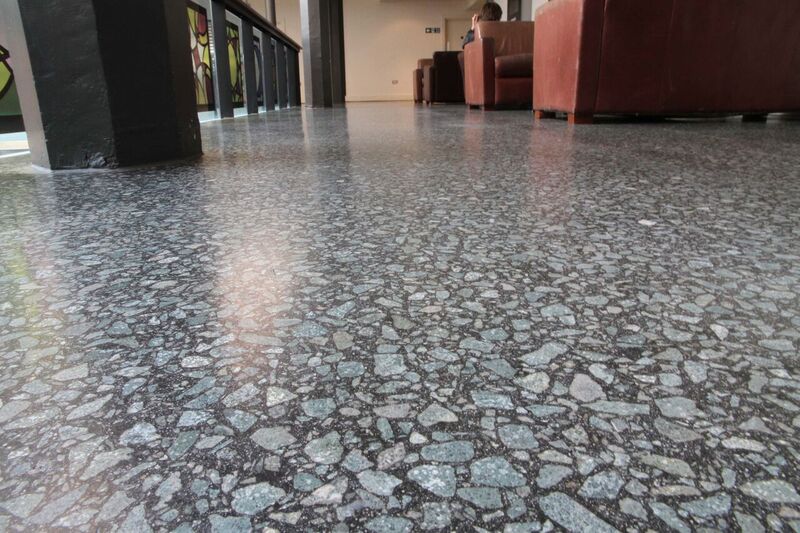Mastic asphalt flooring
Terrazzo mastic asphalt flooring by IKO PLC. Photo credit: Mastic Asphalt Council.
Contents |
[edit] Introduction
The term ‘flooring’ refers to the lower enclosing surface of spaces within buildings. This may be part of the floor structure, such as the upper surface of a concrete slab or floor boards, but typically it is a permanent covering laid over the floor. There are many types of flooring materials available. For more information see Types of flooring.
[edit] Flooring materials
Resilient flooring is loosely defined as flooring manufactured from elastic materials. Products made out of these materials share certain characteristics - they are durable and firm, but they also offer a degree of 'bounce' or resilience. For more information see Resilient flooring.
Mastic asphalt was introduced in the 1900s and became widely used as a type of resilient flooring up until the 1950s. It has experienced an increase in popularity due to useful characteristics inherent in its composition, application and durability.
[edit] Composition
Mastic asphalt is a mixture of fine and coarse limestone and dolomite aggregate and synthetic bitumens. Some grades may also contain natural asphalts, polymer modified bitumens and pigments to create different design effects (such as terrazzo) and colours.
None of the components are classified as hazardous in accordance with the CLP Regulation (EC) no 1272/2008.
Terrazzo mastic asphalt flooring. Photo credit: Mastic Asphalt Council.
[edit] Application
To apply mastic asphalt, the mixture is poured while still hot so it can be distributed evenly. It is then smoothed and left to cool and cure, which takes approximately two to three hours (depending on the temperature in the surrounding environment). This can be an advantage in situations where speed is required.
The thickness of the layer of mastic asphalt can vary, but it typically ranges from 15mm to 50mm, depending on various factors and requirements of the application.
[edit] Durability
While mastic asphalt flooring is not common compared to other types of flooring, it does have advantages in both commercial (in particular industrial, education and healthcare) and domestic applications, especially when water protection is a priority. Due to its water resistant nature, mastic asphalt flooring can be used as a protective layer under carpet, wood and other types of flooring.
In laboratories or manufacturing environments where chemicals and acids (other than solvents) are present and spark resistance is a factor (it has a non-flammable classification of Bfl-s1, under to EN 13501-1) mastic asphalt can also be a suitable flooring option. Warehouses and shop floors that experience regular traffic from equipment such as forklifts and pneumatic trolleys are suitable for mastic flooring.
However, if the surface will have to support heavy, permanent equipment, a mastic asphalt floor may become misshapen from the weight of the load. Therefore, it is important to select Type F1076 mastic asphalt for flooring that is graded according to usage, as follows:
- Grade I - Special hard flooring.
- Grade II - Light duty flooring.
- Grade III - Medium duty flooring.
- Grade IV - Heavy duty flooring.
[edit] Related articles on Designing Buildings Wiki
Featured articles and news
The UK’s largest air pollution campaign.
Future Homes Standard, now includes solar, but what else?
Will the new standard, due to in the Autumn, go far enough in terms of performance ?
BSRIA Briefing: Cleaner Air, Better tomorrow
A look back at issues relating to inside and outside air quality, discussed during the BSRIA briefing in 2023.
Restoring Abbotsford's hothouse
Bringing the writer Walter Scott's garden to life.
Reflections on the spending review with CIAT.
Retired firefighter cycles world to raise Grenfell funds
Leaving on 14 June 2025 Stephen will raise money for youth and schools through the Grenfell Foundation.
Key points for construction at a glance with industry reactions.
Functionality, visibility and sustainability
The simpler approach to specification.
Architects, architecture, buildings, and inspiration in film
The close ties between makers and the movies, with our long list of suggested viewing.
SELECT three-point plan for action issued to MSPs
Call for Scottish regulation, green skills and recognition of electrotechnical industry as part of a manifesto for Scottish Parliamentary elections.
UCEM becomes the University of the Built Environment
Major milestone in its 106-year history, follows recent merger with London School of Architecture (LSE).
Professional practical experience for Architects in training
The long process to transform the nature of education and professional practical experience in the Architecture profession following recent reports.
A people-first approach to retrofit
Moving away from the destructive paradigm of fabric-first.
International Electrician Day, 10 June 2025
Celebrating the role of electrical engineers from André-Marie Amperè, today and for the future.
New guide for clients launched at Houses of Parliament
'There has never been a more important time for clients to step up and ...ask the right questions'
The impact of recycled slate tiles
Innovation across the decades.
EPC changes for existing buildings
Changes and their context as the new RdSAP methodology comes into use from 15 June.

























